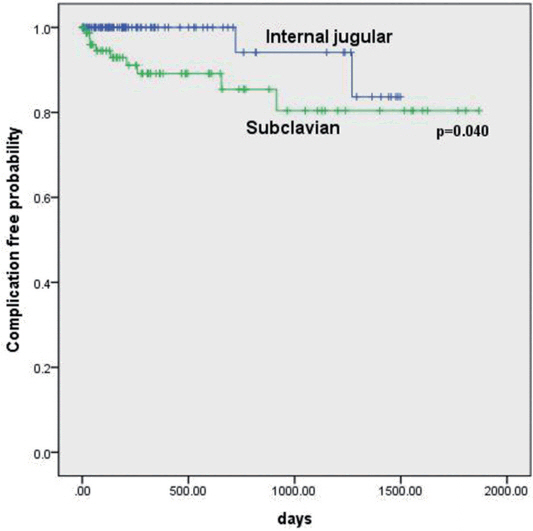Korean J Crit Care Med.
2015 Feb;30(1):13-17. 10.4266/kjccm.2015.30.1.13.
Complications of Central Venous Totally Implantable Access Port: Internal Jugular Versus Subclavian Access
- Affiliations
-
- 1Department of Surgery, Wonju College of Medicine, Wonju Severance Christian Hospital, Wonju, Korea.
- 2Department of Thoracic and Cardiovascular Surgery, Wonju College of Medicine, Wonju Severance Christian Hospital, Wonju, Korea. nicecs@yonsei.ac.kr
- 3Department of Anesthesiology, Wonju College of Medicine, Wonju Severance Christian Hospital, Wonju, Korea.
- KMID: 2227694
- DOI: http://doi.org/10.4266/kjccm.2015.30.1.13
Abstract
- BACKGROUND
Totally implantable access port (TIAP) provides reliable, long term vascular access with minimal risk of infection and allows patients normal physical activity. With wide use of ports, new complications have been encountered. We analyzed TIAP related complications and evaluated the outcomes of two different percutaneous routes of access to superior vena cava.
METHODS
All 172 patients who underwent port insertion with internal jugular approach (Group 1, n = 92) and subclavian approach (Group 2, n = 79) between August 2011 and May 2013 in a single center were analyzed, retrospectively. Medical records were analyzed to compare the outcomes and the occurrence of port related complications between two different percutaneous routes of access to superior vena cava.
RESULTS
Median follow-up for TIAP was 278 days (range, 1-1868). Twenty four complications were occurred (14.0%), including pneumothorax (n = 1, 0.6%), migration/malposition (n = 4, 2.3%), pinch-off syndrome (n = 4, 2.3%), malfunction (n = 2, 1.1%), infection (n = 8, 4.7%), and venous thrombosis (n = 5, 2.9%). The overall incidence was 8.7% and 20.3% in each group (p = 0.030). Mechanical complications except infectious and thrombotic complications were more often occurred in group 2 (p = 0.033). The mechanical complication free probability is significantly higher in group 1 (p = 0.040).
CONCLUSIONS
We suggest that the jugular access should be chosen in patients who need long term catheterization because of high incidence of mechanical complication, such as pinch-off syndrome.
MeSH Terms
Figure
Reference
-
References
1. Ruesch S, Walder B, Tramèr MR. Complications of central venous catheters: internal jugular versus subclavian access-a systematic review. Crit Care Med. 2002; 30:454–60.
Article2. Galloway M. Insertion and placement of central catheters in the oncology patient. Semin Oncol Nurs. 2010; 26:102–12.
Article3. Broviac JW, Cole JJ, Scribner BH. A silicone rubber atrial catheter for prolonged parenteral alimentation. Surg Gynecol Obstet. 1973; 136:602–6.4. Seiler CM, Frohlich BE, Dorsam UJ, Kienle P, Buchler MW, Knaebel HP. Surgical technique for totally implantable access ports (TIAP) needs improvement: a multivariate analysis of 400 patients. J Surg Oncol. 2006; 93:24–9.
Article5. Frykholm P, Pikwer A, Hammarskjöld F, Larsson AT, Lindgren S, Lindwall R, et al. Clinical guidelines on central venous catheterisation. Swedish Society of Anaesthesiology and Intensive Care Medicine. Acta Anaesthesiol Scand. 2014; 58:508–24.6. Silberzweig JE, Sacks D, Khorsandi AS, Bakal CW, Society of Interventional Radiology Technology Assessment Committee. Reporting standards for central venous access. J Vasc Interv Radiol. 2003; 14(9 Pt 2):S443–52.
Article7. Biffi R, Orsi F, Pozzi S, Pace U, Bonomo G, Monfardini L, et al. Best choice of central venous insertion site for the prevention of catheter-related complications in adult patients who need cancer therapy: a randomized trial. Ann Oncol. 2009; 20:935–40.
Article8. Wu CF, Ko PJ, Wu CY, Liu YH, Kao TC, Yu SY, et al. A single-center study of vascular access sites for intravenous ports. Surg Today. 2014; 44:723–31.
Article9. Shin BS, Ahn M. Implantable central venous chemoport: comparision of results according to approach routes and methods. J Korean Radiol Soc. 2003; 49:165–71.
Article10. Araújo C, Silva JP, Antunes P, Fernandes JM, Dias C, Pereira H, et al. A comparative study between two central veins for the introduction of totally implantable venous access devices in 1201 cancer patients. Eur J Surg Oncol. 2008; 34:222–6.
Article11. Silas AM, Perrich KD, Hoffer EK, McNulty NJ. Complication rates and outcomes of 536 implanted subcutaneous chest ports: do rates differ based on the primary operator’s level of training? Acad Radiol. 2010; 17:464–7.12. Keum DY, Kim JB, Chae MC. Safety of a totally implantable central venous port system with percutaneous subclavian vein access. Korean J Thorac Cardiovasc Surg. 2013; 46:202–7.
Article13. Schwarz RE, Groeger JS, Coit DG. Subcutaneously implanted central venous access devices in cancer patients: a prospective analysis. Cancer. 1997; 79:1635–40.14. Ge X, Cavallazzi R, Li C, Pan SM, Wang YW, Wang FL. Central venous access sites for the prevention of venous thrombosis, stenosis and infection. Cochrane Database Syst Rev. 2012; 3:CD004084.
Article15. Mirza B, Vanek VW, Kupensky DT. Pinch-off syndrome: case report and collective review of the literature. Am Surg. 2004; 70:635–44.16. Aitken DR, Minton JP. The “pinch-off sign”: a warning of impending problems with permanent subclavian catheters. Am J Surg. 1984; 148:633–6.
Article17. McGee DC, Gould MK. Preventing complications of central venous catheterization. N Engl J Med. 2003; 348:1123–33.
Article
- Full Text Links
- Actions
-
Cited
- CITED
-
- Close
- Share
- Similar articles
-
- Catastrophic hemothorax on the contralateral side of the insertion of an implantable subclavian venous access device and the ipsilateral side of the removal of the infected port: A case report
- Totally Implantable Venous Access Devices In Pediatric Surgery Patients
- Clinical Review of Totally Implantable Venous Catheter
- Erratum: Complications of Central Venous Totally Implantable Access Port: Internal Jugular Versus Subclavian Access
- Safety of a Totally Implantable Central Venous Port System with Percutaneous Subclavian Vein Access


